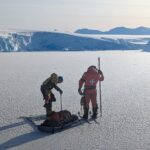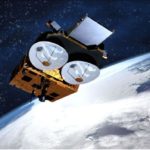Overview
While climate models suggest Antarctic sea ice extent should also reduce in response to rising atmospheric CO2 concentraions, satellite observations reveal that during 1979-2015 the opposite was in fact true. The trend in Antarctic sea ice extent has been a small increase of approximately 1.5% per decade. In 2016, however, this increase was abruptly interrupted by a dramatic reduction in sea ice extent that was far outside the previously observed range. Since the extreme event in 2016, Antarctic sea ice extent has almost returned to its pre-2016 values, highlighting the significant variability in Antarctic sea ice conditions that can occur from one year to the next. These variations in sea ice are important to the whole Earth’s climate, because they affect the melting of the glacial Antarctic Ice Sheet, and the capture of atmospheric heat and CO2 by the Southern Ocean.
The recent extreme swings in Antarctic sea ice extent, and the challenge of accurately predicting, understanding and modelling them, emphasise the need to:
(i) increase our knowledge of the processes that drive Antarctic sea ice variations, including extreme events, and
(ii) understand the drivers and climate implications of Antarctic sea ice loss over different time-scales, from weeks to decades.
To address this knowledge gap requires a significant research programme, one that takes year-round observations, including throughout the harsh Antarctic winter, and is effective in improving the underlying processes in the latest computer climate models.
Our project, known as DEFIANT (Drivers and Effects of Fluctuations in sea Ice in the ANTarctic), will embark on one of the most ambitious observational campaigns aimed at understanding Antarctic sea ice variability. Scientific measurements from the German research ship RV Polarstern, the UK’s new polar research ship Sir David Attenborough, the British Antarctic Survey’s Rothera research station, aircraft overflights and satellites will work seamlessly together with cutting-edge robotic technologies (including the underwater vehicle Boaty McBoatface and a suite of on-ice buoys) to provide us with comprehensive, year-round measurements of atmosphere, sea ice and ocean. The knowledge gained from these observations will enable our team to develop new ocean and climate models in order to more accurately represent Antarctic sea ice processes.
The analysis of these improved models will allow us to better understand the underlying drivers of the sudden decrease in Antarctic sea ice, determine the impact of these extreme events on the global ocean circulation, and forecast the implications for the movements of heat and CO2 through the climate system. By developing new observations, new satellite records, and new models, DEFIANT will deliver a major advance in our understanding of the Antarctic sea ice system and its wider impacts on global climate.
Funders and Participants
DEFIANT is funded by the Natural Environment Research Council (NERC), part of UK Research and Innovation (UKRI), under the Highlight Topic entitled Drivers and climate implications of recent rapid loss of Antarctic sea ice. By their very nature Highlight topics We encourage multidisciplinary research and collaborations with other UK organisations. As well as with other international and non-academic collaborators.
DEFIANT project was co-designed and co-produced by a consortium of 8 UK Institutes
1. British Antarctic Survey (BAS): Lead Institute
2. National Oceanography Centre (NOC)
3. The Alan Turing Institute (ATI)
4. University College London (UCL: CPOM)
5. University of Leeds (UoL: CPOM)
6. University of Reading (UoR: CPOM)
7. University of Southampton (UoS)
8. UK Met Office (MetO)
Along with institute from
Australia
Canada
Germany
Europe: European Space Agency
India
Norway
Spain
USA
The Specific Objectives (SOs) of DEFIANT are as follows:
SO1: Identify the atmospheric and oceanic processes that caused the 2016 rapid decline in Antarctic sea ice.
SO2: Improve the physical representation of the processes responsible for historical changes in Antarctic ice, ocean, and atmosphere models, including the decadal growth and recent collapse.
SO3: Identify the short-term (<10 years) effect of the sudden decrease in Antarctic sea ice on global oceanic circulation patterns using model simulations with improved physics.
SO4: Combine historical observations and model predictions to assess whether enhanced variability and loss of sea ice constitute a new normal and examine the implications for exchange and redistribution of heat and CO2 over decadal timescales.
SO5: Synthesise advances from above SOs, disseminate knowledge gained and deliver new climate modelling tools.
Delivery plan
Achieving our SOs requires a substantial, multi-disciplinary delivery plan, and extensive international cooperation. The DEFIANT team will (i) perform observations of governing processes to develop an enhanced process-level understanding of sea ice variability, especially in relation to the 2016 extreme event; (ii) deliver better representation of the underlying physics of these governing processes into models; (iii) provide more accurate predictions, through model enhancement, calibration and validation, of short-term (<10 years) impacts of sudden sea ice loss on global oceanic circulation patterns, and long-term (>10 years) implications for exchange and redistribution of heat and CO2; and (iv) spread our new knowledge and modelling tools to the widest possible audience.
The SOs are achieved through four interlinked Work Packages (WPs). Within WPs1-3 we address the key research questions and each WP’s closing task is a synthesis of the knowledge gained. This information feeds into WP4, which focuses on synthesis, dissemination, and training and education. A significant WP4 output is the delivery of a White Paper that summarises the state of knowledge on Antarctic sea ice, including the impacts of sudden reductions in ice extent. This will provide a comprehensive follow-up to the US NAS workshop on Antarctic sea ice.

30 August, 2023 by Emily Newton
Dr Robbie Mallett is a sea ice scientist, currently over-wintering at Rothera Research Station in Antarctica as part of an eight-month research campaign for the NERC DEFIANT project. Robbie explains the …
11 May, 2023
The 2022/23 Antarctic field season has ended, marking the conclusion of another successful year of scientific exploration in one of the world’s most remote and challenging environments. This field season, …
20 December, 2022
An ambitious flying campaign out of British Antarctic Survey’s Rothera Research Station over the Weddell Sea this month (December) aims to calibrate the data collected from two important satellites that …



